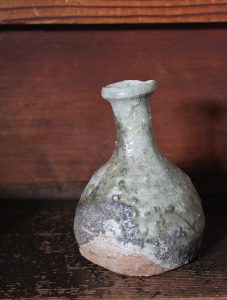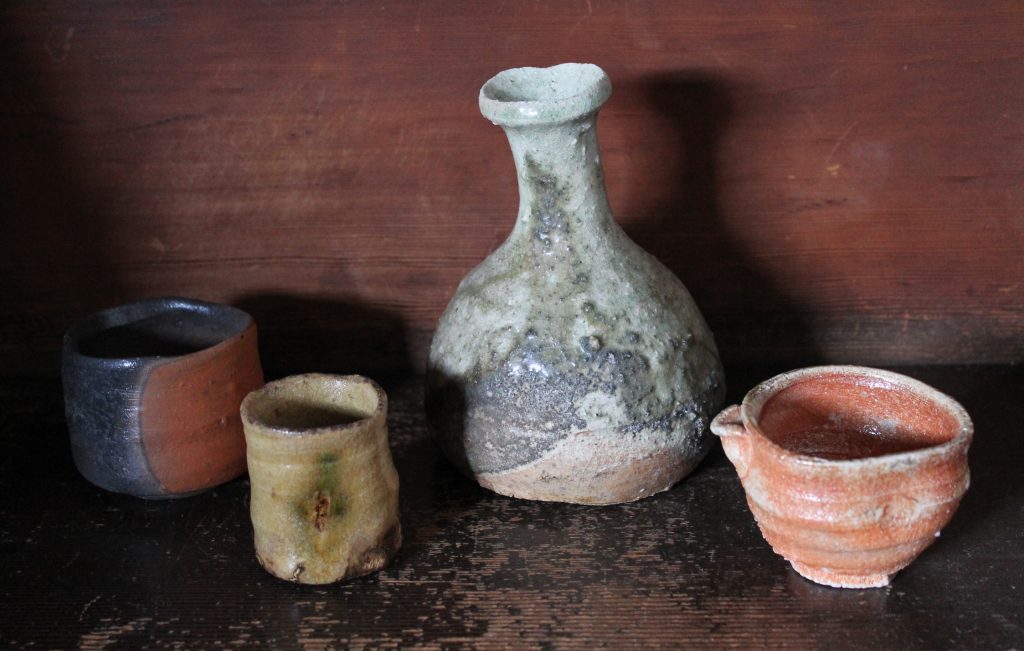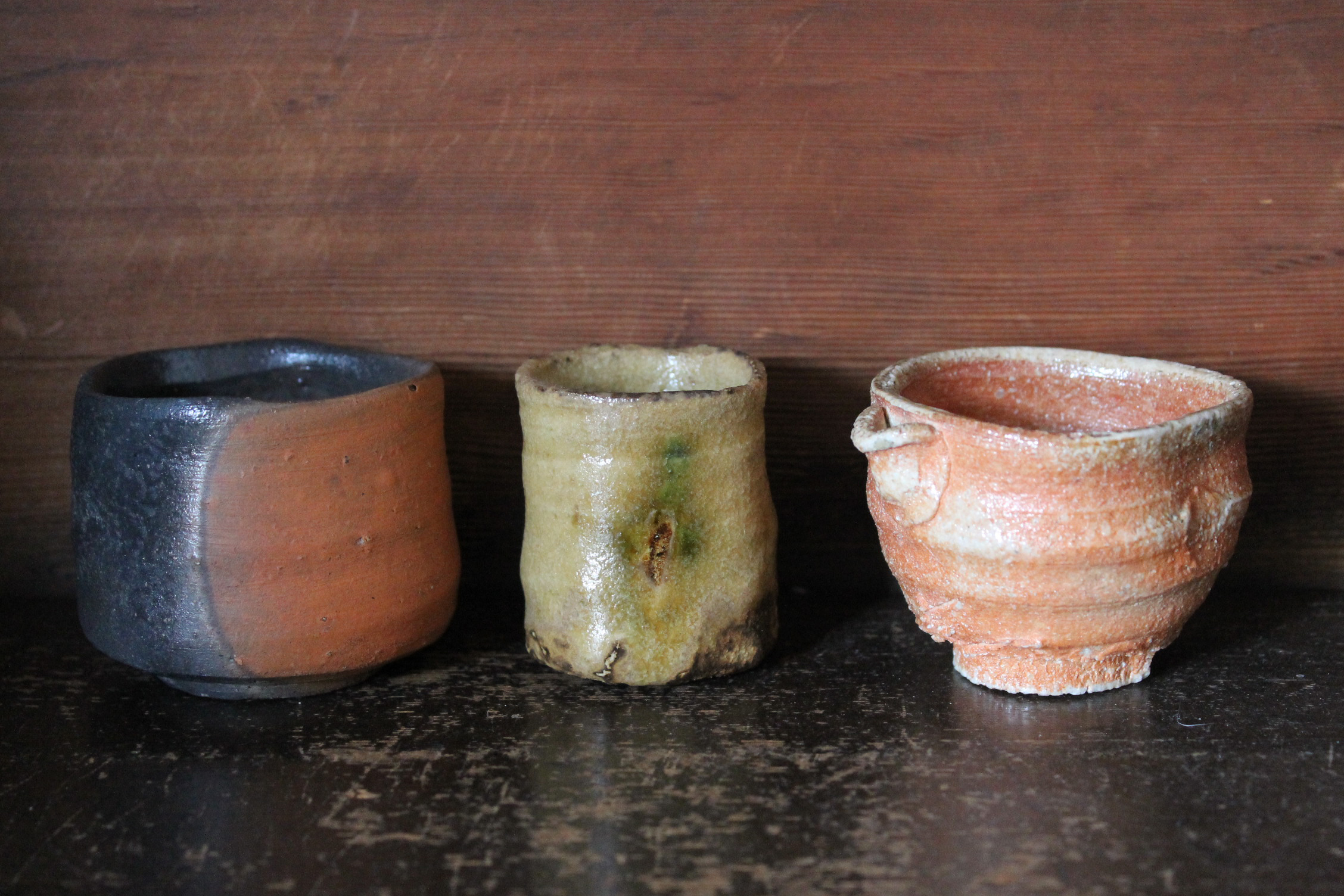‘Pride of Place—Sake Vessels’
Drinking sake in Japan is an art when done with the right vessels. The history of sake vessels—collectively called shuki in Japanese—dates back millenniums and the variety of shuki found throughout Japan is as varied as there are clouds in the sky. For me, collecting shuki was my introduction into the Japanese pottery world as a young twenty-something in 1984 who couldn’t afford an expensive imported California Cabernet Sauvignon and so I thought better to go local, and that of course meant sake.

Almost all potters in Japan make shuki and they are avidly collected, often the first items to sell-out at exhibitions. Some of the earliest pieces I bought are shown here and have taught me quite a lot about Japanese history, regional styles, the joy of functional art, and of course the immense pleasure that comes with using fine vessels at the table, something the Japanese call Yo-no-Bi or Beauty through Use.
Iga is one of Japan’s ancient high-fired unglazed stonewares named after the town it was made in, as often is the case for Japanese styles. And shown here is an Iga tokkuri—or flask—by the celebrated potter Shiro Tsujimura. At first I didn’t ‘get it.’ Look, the neck is leaning, there’s grit all over it, the base has a fused bit of clay on it, the glazing is uneven! In most western traditions—and certainly at art schools—this would have been a failure piece, yet here in Japan it’s the epitome of good taste. The reason being we find nature and man working together without one wanting to totally control each other or the process, yet letting intuition, passion, experience, and letting go take over. Meaning the beauty of this Tsujimura tokkuri is of course the clay he dug, processed and formed, yet also his willingness to let the process also have a say in the outcome, in a sense what we might call the ‘Beauty of the Imperfect.’ Kind of like you and I.
In the picture below I‘ve matched the Iga tokkuri with three of my most treasured guinomi or sake cups: a slender Ki-Seto (Yellow Seto) by Shukai Kagami, a robust Bizen by Rokuro Nakamura and a spouted Shigaraki by Michio Furutani. I had the honor and pleasure to have met all three of these now gone potters and each had a heart of gold, for as the 6th B.C. Chinese poet Lao Tsu said, “There is no real beauty without character.”

Kagami devoted his life to Ki-Seto, one of the Mino styles of pottery, the others being Shino, Oribe and Black Seto. There’s richness to Kagami’s Ki-Seto glazing that no other Japanese potters have been able to re-produce. The subtly of the green copper embellishments along with the brown-toasty shades make this delicately carved slender work a masterpiece of his.
Nakamura was known mostly for his shuki, although he did make other forms. He learned from drinking experience, often taking a 1.8 liter bottle of sake and starting the day with 380ml, same at lunch, tea time called for another round and then of course the bottle was emptied at dinner; he lived to be 90. Once he told me the lip of a good guinomi should touch the lips as if you’re kissing your lover. One can see here the undulating and angled lines that make this guinomi do just that. The tones are autumnal with what the Japanese call good ‘clay flavor.’ As with cooking, a Japanese potter often wants to bring out the inherent ‘flavor’ found within the ingredients used. That especially holds true for Japan’s great unglazed stonewares such as Bizen, Iga, Tamba or Shigaraki.
This aspect is also clearly seen on the spouted Shigaraki guinomi by Michio Furutani. The orange-tones are called ‘hi-iro’ or ‘fire-color’ and are one of the most distinctive characteristics of Shigraki, the others being shizen-yu or natural ash-glaze and bidoro, goblets of natural ash glaze that form glass-like beads on pieces. Here the spouted lip is merely for decoration and one would not pour sake into their mouth via it! As with most stonewares over time the piece changes and takes on a richer patina, this piece surely has seen a lot of sake and I often dipped my finger in the cup and rubbed sake on the outside; I once saw a Japanese collector do that as well as rub nose oil on a piece! Furutani was a master kiln builder as well, building more than thirty in his all-too-short life with the aim for each kiln to bring out desired effects. He was most often successful at that and wrote the Japanese potter’s anagama single-chamber kiln building ‘Bible.’
Such deep joy these pieces have given me over the years, simple timeless joy. They have taught me about many of the grand ceramic traditions here in Japan, they allowed me to meet fascinating artists, they have provided me with poetic inspiration and of course functional beauty, and that in a nutshell is why I love Japanese ceramics as much as I do.
Kampai!
************
For Robert’s gallery, see the Yakimono Gallery.
For an introduction to Robert’s lifework, see here.
Click here for Robert’s book, Ode to Japanese Pottery.

